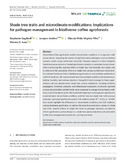Shade tree traits and microclimate modifications: Implications for pathogen management in biodiverse coffee agroforests
Abstract
Diversified coffee agroforests modify microclimate conditions in comparison with monocultures, impacting the success of significant plant pathogens, such as Hemileia vastatrix, which causes coffee leaf rust (CLR). However, research is often limited to the dichotomous analysis of shaded agroforestry systems or unshaded monocultures, often overlooking the nuanced effect of shade tree trait diversity. Our study aims to determine the cumulative effects of shade tree canopy architectural characteristics and leaf functional traits in biodiverse agroforests on microclimate modifications and CLR incidence. We measured plot-level microclimate conditions (air temperature, relative humidity, leaf wetness duration, throughfall kinetic energy) in three single-stratum and two double-strata shade tree canopy treatments, including Erythrina poeppigiana, Terminalia amazonia, and Chloroleucon eurycyclum. Commonly reported canopy characteristics and leaf traits were compared to average microclimate conditions and CLR incidence levels. We found that shade tree trait expression significantly explained most microclimate conditions, and that two key shade tree traits (canopy openness, leaf area) significantly explain CLR incidence levels (R2 = 0.211, p = 0.036). Our results highlight the differences in microclimate conditions and CLR incidence among biodiverse agroforests, as well as the important explanatory power of shade tree traits. Specific effects of shade tree traits on pathogen dynamics can directly inform agroforestry system design (i.e., shade tree species selection) and sustainable coffee farm management practices (i.e., pruning practices).
Keywords
Publisher
Wiley Biotropica, New Jersey (Estados Unidos)
Is part of
Biotropica


